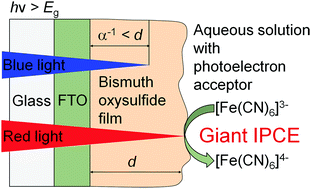Authors: Evgeny A. Bondarenko, Eugene A. Streltsov, Alexander V. Mazanik, Anatoly I. Kulak, Vytautas Grivickas, Patrik Ščajev,

Physical Chemistry Chemical Physics, 2018, 20, pp 20340-20346
Abstract
It was demonstrated in our previous work that the photoelectrochemical (PEC) reduction processes occur with a giant incident photon-to-current conversion efficiency (IPCE ≫ 100%) at bismuth oxysulfide (BOS) semiconductor films in aqueous solutions containing acceptors of photoelectrons ([Fe(CN)6]3−). The anomalously high IPCE was related to the photoconductivity of the semiconductor. In this work, we analyze the dynamics of the chemical and phase composition of BOS films with variation of their deposition time, as well as the dependence of photocurrent on the film thickness and wavelength of the incident light. We demonstrate that in the case of illumination with a short-wavelength light (λ = 465 nm), the photocurrent is reduced down to a complete disappearance with an increase in the film thickness in the range of 0.3–1.3 μm, and for a fixed thickness of the bismuth oxysulfide film, the photocurrent decreases with the reduction of the wavelength indicating that photogeneration of the charge carriers over the entire thickness of the film is necessary for the giant IPCE effect. Using the light induced transient grating (LITG) method, the lifetime of the charge carriers (τ) was determined in the range of 25–80 ps depending on the film thickness, whereas the diffusion coefficient (D) does not exceed 1 cm2 s−1 meaning that the charge transport across the films is determined only by drift.
DOI: 10.1039/c8cp03225d
Read full: